7.1 How does the PV industry chain carry out “vertical integration�
At present, China's PV companies have achieved strong competitive advantages in the world. Otherwise, the United States and the European Union will not repeatedly and repeatedly use the "double-reverse" sticks to impose sanctions on China's PV companies. At present, the photovoltaic industry is at the “critical point†stage of price breakthrough and the trough and reshuffle period of the whole industry. Faced with the climax of the upcoming PV industry development, a group of old PV manufacturing enterprises are due to heavy debt and outdated production equipment. The accumulation is hard to return, and it is powerless. For other companies, this is a golden opportunity.
In other words, "double opposition" is both a challenge and an opportunity. Since 2008, many PV companies have talked about “vertical integrationâ€. This is because the shortage of polysilicon, ingots and battery cells have been insufficient in the turn. Many companies have learned that they must implement the whole industry. The "vertical integration" of the chain, once the owner of a photovoltaic company once proudly said in CCTV media, "We are the longest and most complete photovoltaic enterprise in the world's industrial chain", then, if the industrial chain is complete, it must have What about competitive advantage?
Whether the industrial chain is complete or not, in the current situation of the growing size of the photovoltaic market, it is actually not the most important. At present, it is more important for China's PV companies to make full use of local advantages to build each enterprise in the industrial chain into a manufacturing enterprise with high technical level and strong market competitiveness, and to form comprehensive energy consumption through collaborative manufacturing. Low-cost, low material consumption, high production efficiency, high technical level of photovoltaic power generation industry chain manufacturing enterprise group, to create a number of world-class high-quality photovoltaic manufacturing brands. This requires careful planning and construction, and pays great attention to and coordinated management in the operation process, and establishes a high-end manufacturing system of intelligent manufacturing, advanced manufacturing, and lean manufacturing, so that China's PV companies are not afraid of any international pressure, and remain internationally. Long-lasting leadership.
7.2 Production capacity of photovoltaic industry chain
If a PV company tries to achieve the production of the whole industry chain, and finally only exports the components, the production capacity of each link within the industry chain must meet the production capacity of each link of the upper and lower industrial chains in accordance with the principle of capacity balance. Table 7-1 shows the capacity data of each link in the PV manufacturing industry chain with 1 GW of component output capacity as an example.

In principle, an enterprise can realize the production capacity of the whole industry chain from beginning to end. Although it can meet the supply demand of the upstream and downstream of the industrial chain, once the industry has a turmoil, the systemic risk may be even greater. Therefore, a company only selects one or two links to make it bigger, and the production capacity is defined according to the market. A fine division of labor will result in better efficiency.
If a company wants to do the whole industry chain, the best way may be to make the more scarce links in the market bigger than the market situation, so that your company has a certain export in this link, rather than all internal digestion. In this way, the risk may be smaller and production will be more stable. For example, at present, although China's PV industry chain claims to have overcapacity, more than half of the polysilicon is imported, and the ingots are also experiencing tight production capacity. In this way, enterprises can appropriately amplify the production capacity of polysilicon and ingot slicing. And external sales will bring better benefits to the company and win stable partners in the industry.
In addition, it should be noted that the production capacity of the industrial chain is not fixed. Therefore, it is better to adopt flexible manufacturing technology to achieve variable-capacity production within a certain range. This is a modernized industry in the case of rapid changes in market demand. Chain photovoltaic companies are very important.
7.3 Spatial layout of photovoltaic industry chain planning
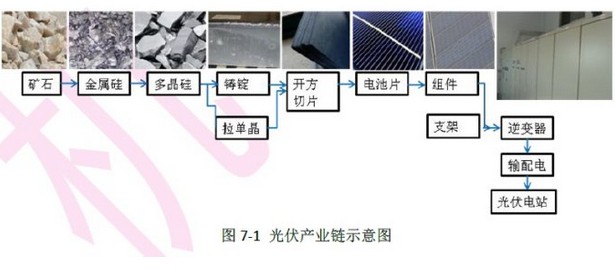
Figure 7-1 shows the main industrial chain of the photovoltaic industry from ore to photovoltaic power plants. As can be seen from the figure, the industrial chain of photovoltaic manufacturing is very long, from the production of ore, metal silicon smelting, polysilicon production, polycrystalline silicon ingots, silicon wafers, battery chips, photovoltaic modules and inverters.
The “vertical integration†of the PV industry chain has a big problem. It is impossible to achieve the best production of all links in the entire industry chain at any time. This is because each link has different requirements for the geographical environment. For example, the production of metal silicon needs to be close to the silica mine. The metal smelting needs to be abundant and the electricity price is low. The purification, ingot casting and slicing of polysilicon need to be in the place where the electricity price is low and close to the market, and the production of polycrystalline silicon battery needs Good raw and auxiliary materials, and PV modules are better near the terminal market, that is, near the photovoltaic power station due to high freight rates. Therefore, in the layout of the photovoltaic manufacturing industry chain, it is not appropriate to concentrate on a single region or city to implement a large and complete vertical integration, but a fine division of labor should be carried out, and the factories in each link should be dispersed in the production that is most beneficial to the link. Local, and optimize the distribution of manufacturing origin, take advantage of resources, policies, capital, market and other advantages around the world, set the appropriate factories according to local conditions, to achieve the optimal setting of the entire industrial chain.
For example, the production capacity of polysilicon will be concentrated in the energy resources of the central and western regions, and the component production capacity will be as close as possible to the localized manufacturing of the market, while the middle silicon wafer and battery segments will be gathered in areas with better industrial supporting conditions to form a comprehensive synergy. Photovoltaic manufacturing industry chain gathering area, at the same time, each enterprise in this gathering area must have its own unique technological advantages, produce the best quality and most efficient products with the lowest cost and best technology, and make the photovoltaic industry chain Every aspect of the process can guarantee supply and continuously improve the technical level.
In view of the current trend of trade protectionism in Europe and the United States, in addition to setting up factories in the country, setting up production plants in the United States, Europe and other parts of the world to avoid trade barriers is a necessary step. At the same time, in addition to considering the trade barriers, the overseas investment in setting up factories must also consider the location selection from the aspects of optimizing the manufacturing origin distribution, learning the foreign advanced advanced manufacturing technology, and gathering global innovation resources to promote the photovoltaic enterprises in China. International development. Selecting a photovoltaic manufacturing company with strong technical background, management, technology and sales team in Europe and America, in the form of company acquisition, asset acquisition, joint venture and other forms of construction, after the control, the first run-in, after the production is stable, then expand production To carry out the production of all aspects of the photovoltaic industry chain, and establish an overseas photovoltaic manufacturing base for China's photovoltaic enterprises. The stone of other mountains can be used to attack jade. In the process of building and expanding overseas photovoltaic manufacturing bases, we must pay attention to learning advanced technology and manufacturing experience from abroad to improve our technology and manufacturing level.
At present, the overseas PV equipment manufacturing base can first respond to and cooperate with the PV trading business of China's PV companies overseas, and at the same time, in conjunction with the construction progress of local PV power plants. The establishment of overseas factories depends on the actual situation to decide whether to adopt a new factory or to acquire an existing company. Considering the high transportation costs of components, it is not recommended to build a single overcapacity component plant.
In addition, when constructing photovoltaic manufacturing plants in various places, we must maximize the preferential policies of the local governments and the central government, including land, taxation, talents, and funds. European and American countries have their own industrial concessions and support policies for the photovoltaic industry. It is necessary to pay attention to the local structure and strive for it.
Given that the PV industry chain is destined to be geographically and not in one region, and may be very distant from each other, and may even be at the ends of the Earth, it is important to coordinate the wines at the factories within the industry chain. In addition to the management of supply chain, logistics, and human resources, enterprises must give full play to the advantages of information technology and build a unique "cloud manufacturing" system of collaborative manufacturing, advanced manufacturing, and intelligent manufacturing to enhance their core competitiveness.
7.4 Time expansion of the PV industry chain
From the macro perspective of the entire photovoltaic industry in the world, the production capacity of the photovoltaic manufacturing industry chain should be synchronized with the construction of photovoltaic power plants. In the implementation, no matter how strong a company's strength, it is impossible to spread the entire industry chain at the same time, and should not do so. Instead, start with one or a few links and then gradually expand to other links.
The first step in the construction process is to select the links that are relatively scarce at the time. For example, polysilicon production in the current market, as well as ingot slicing. If the company invests in power plant operations at the same time, it is also possible to build a component factory first. Although the capacity of the components is surplus, the production of components by itself is not only a cost advantage, but also an advantage of future product maintenance and service. Of course, it is by no means recommended that all power station operators have their own manufacturing plants, but rather those that plan to invest in power plants and plan to invest in photovoltaic manufacturing.
After the construction of the first stage of the plant, the capacity expansion in the second phase will also be based on the market conditions of the photovoltaic industry and the manufacturing advantages of the company. For those links that are lacking in the market and have their own manufacturing advantages, priority should be given to expansion. For those parts of the company that are sometimes not strong in manufacturing or overcapacity in the market, we can first consider the "OEM" approach, which not only digests the excess capacity of the market, but also enables ourselves to achieve "light asset expansion" and reduce investment risk.
In the process of enterprise's industrial chain expansion, we must always pay attention to make each manufacturing process achieve "flexible manufacturing", that is, the production capacity can not be too rigid, but can achieve profit and capital preservation within a large range of changes, in view of the photovoltaic market. It is an emerging market, it is very volatile, and it is changing rapidly. Therefore, the flexibility of manufacturing plants is very necessary for enterprises, and even for life and death.
In addition to the flexibility of manufacturing, companies must also actively play the role of information technology, keep abreast of the latest information in the global PV market, capture important information, and timely adjust the preparation, procurement, inventory and manufacturing status of each enterprise within its industrial chain. To achieve true information manufacturing. In these enterprises, information technology is not the decoration of the facade, but the production equipment that is the same as the main production equipment, and even more important, directly related to the competitiveness of the enterprise.
7.5 accessories! Link that cannot be ignored
When most people consider investing in the photovoltaic industry, they will focus on the above-mentioned main industrial chain. In fact, in addition to the above-mentioned main industrial chain, photovoltaic manufacturing also has an auxiliary material industry chain. The production of these auxiliary materials is also very important for the bamboo industry chain, such as bismuth, graphite, carbon felt, aluminum paste, silver paste, and ultra-white glass. , EVA film, copper foil tape, aluminum alloy has been the production of industrial gases and other materials, these accessories, whether it is production or quality, are closely related to the photovoltaic industry chain. Figure 7-4 shows the auxiliary materials around the photovoltaic industry chain.
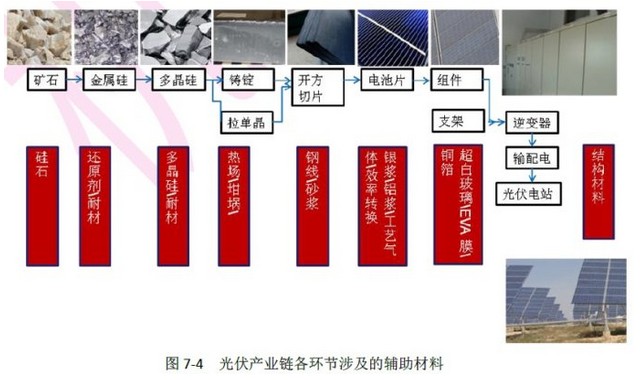
The production of auxiliary materials in China's photovoltaic industry, like the various industrial chains, has achieved impressive results in the international photovoltaic market. For example, the aluminum paste of Ruoxing Technology, the flaw of Huarong, the EVA film of Foster, etc., have squeezed out foreign markets such as DuPont and Vesuvius, which originally occupied the Chinese market, in a few years. What China's accessories manufacturers need to do now is to improve their technological innovation and to develop accessories technology and products that lead the international advanced technology. In addition, for those accessories that still need to be imported, try to fill the gap.
In addition, for the construction of photovoltaic power plants, the development of products for the photovoltaic building integration of power stations, such as photovoltaic power generation to replace the photovoltaic tiles of the current roof tiles, photovoltaic curtain walls, special structural parts for power station installation, for rural greenhouses The multi-functional power generation bracket, and so on, is also an auxiliary material that has not been valued yet, but the market is extremely large.
In addition to the above-mentioned auxiliary materials, there is still a business that cannot be ignored in the photovoltaic manufacturing industry chain, that is, the recycling of silicon materials and auxiliary materials. For example, the recycling of head and tail materials and edge materials in the ingot plant, the mortar and silicon material recovery and regeneration of the slicing plant, the recovery of the ingot plant and the recycling of graphite, and the investment in photovoltaic power plants in the future. After that, the recycling and reprocessing of various auxiliary materials such as ultra-white glass, copper foil, silver paste, aluminum alloy, and back sheet in the components of the power station exceeding the service period.
China is rich in quartz resources, graphite resources, aluminum resources, and is also the main silver producing area in the world. In the domestic selection of suitable places to set up large-scale production and processing bases and distribution centers for photovoltaic industry auxiliary materials, to provide photovoltaic industry with the auxiliary materials needed for manufacturing and power generation, for the balance, improvement and healthy development of China's photovoltaic manufacturing industry chain. Important strategic significance. (Dr. Shi Wei, Chairman of Shanghai Pronew Energy Co., Ltd.)
Aluminum Cap are available within the range of DN 15 – DN 500.
Our high-quality and corrosion resistant Aluminum Pipe End Cap come in various sizes and schedules to fit your Aluminum Fitting needs.
Aluminum Cap is a type of Aluminum Fitting that covers the end of a pipe.On a weld, if it is a temporary close, or the contractor wants to add to the piping system in the future, he or she should allow additional pipe before closing so the Aluminum Pipe End Cap can be cut off and the pipe system extended as needed.
Thickness :
3mm-50mm
Outer diameter:
15mm-500mm
Alloy Grade:
1000 series : 1070A,1060,1100,1200
2000 series :2A11,2017,2A12,2024
3000 series :3003 3A21
5000series :5A02,5052,5A03,5A05,5A06,5083,5086,5454
6000 series :6061,6063,6A02,6082,6005
Surface
Mill Finish, Anodized, Powder Coated, Wooden Finish, Polish
Packing
Export standard
Payment Terms
100% irrevocable L/C at sight or 30% T/T in advance as deposit,70% balance before shipment
MOQ
1 Piece
Delivery time
20-45 days after receiving L/C or deposit
Loading Port
Xingang Port,Tianjin
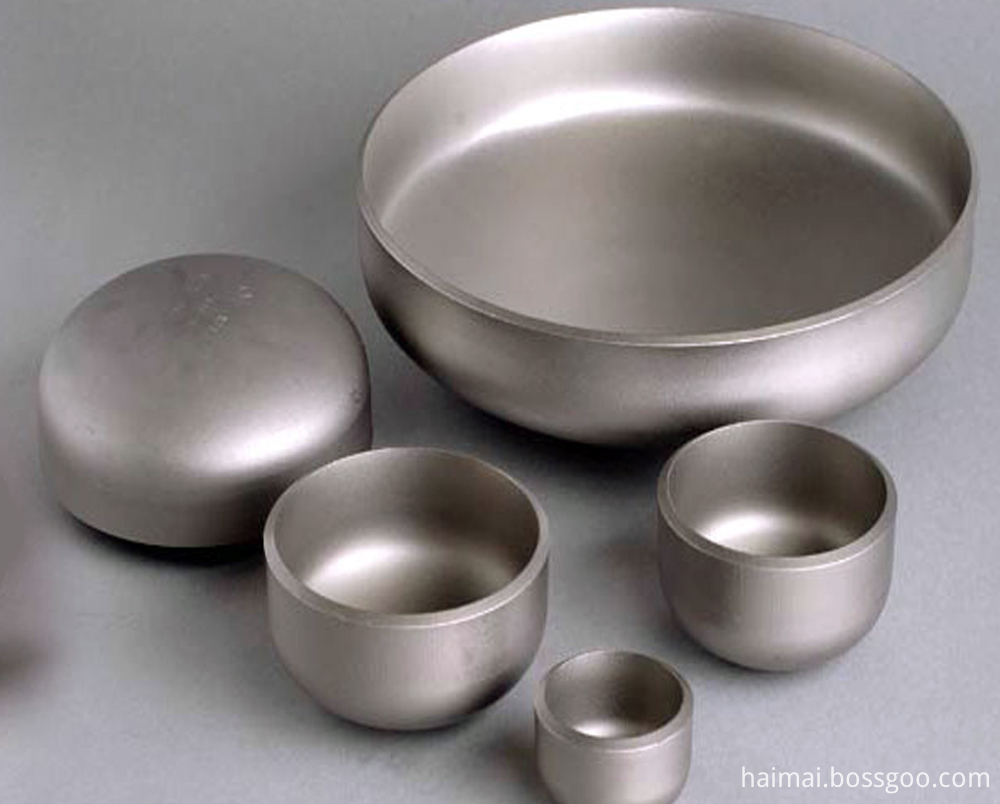
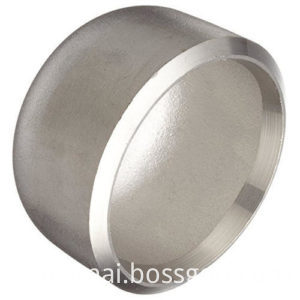
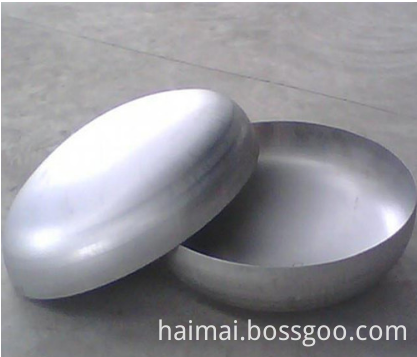
Aluminum Cap
Aluminum Pipe End Cap,Aluminum Fitting,Aluminum Cap,Aluminum 6063 Cap,Aluminum 1060 Cap
HEBEI HANMAC MACHINE CO., LTD. , https://www.chinahanmac.com